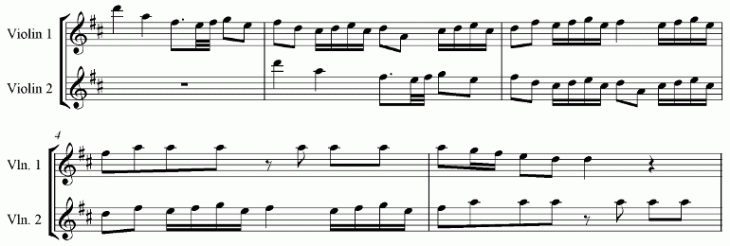- Counterpoint Tutorials -
The Contrapuntal Skeleton - Third Species
In this lesson we introduce quarter notes, the second highest allowable note value in Fux counterpoint, and the fastest note value with real harmonic function. Although no new dissonance types are introduced, the music takes on a much different, more alive feel, due to the increased harmonic rhythm. With more complex counterpoint comes more a pieces more defined as before.
Rules for Third Species
- All second species rules apply, save the the rule restricting all rhythmic values save the whole note and half note.
- You may only use quarter notes.
- Consecutive 3rds and 6ths are more permissible, but be careful to not overuse them.
- Sequences are more effective than ever before - but take care not to overuse them.
- Dissonances may not lie on strong beats or strong parts of the beat, but rather only on weak parts of a beat.
With the use of quarter notes comes a far clearer view of this canon's contour. We're very close to the original piece in terms of mood and proportion. What is missing is the rich dissonance that fourth and fifth species offer - we have excellent infrastructure, but no decorations. Let's examine the score.
Original
Click here to listen!
Third Species, with harmonic interval analysis
Click here to listen!
Hey! How do we know which voice should resolve and which voice should stay still?
It's a bit confusing, isn't it? When both voices move simultaneously and enter a dissonance, like in measure 4, beat 2, how do you go about resolving it? Should both voices step down? Should one move and the other stay? This is a necessary problem that occurs when writing a canon - by it's nature, both parts are moving at almost all times. In stricter counterpoint, there's a largely unmoving bassline, or cantus firmus, but in this example, we don't have to worry about that. For now, let's just be content that we're keeping our dissonances off the strong parts of the beat, and only on weak ones.
Telemann broke a rule! What a terrible composer.
On the contrary - beautiful, isn't it? Part of what makes music wonderful are the minute imperfections. In, again, measure 4 beat 2, Telemann enters a dissonance via a leap in the violin part, but it's done in a tasteful and entertaining way - Telemann is building up tension by going up higher and higher in the register. In your own counterpoint, try to avoid breaking rules unless you have a very clear idea of why you're breaking it - perhaps you've somehow caught yourself in a situation where you can't avoid breaking a rule, or you want to achieve something very specific musically. Either way, take note of these little imperfections in the counterpoint of master composers like Telemann, and try to understand why they did what they've done.


